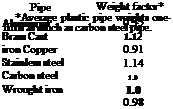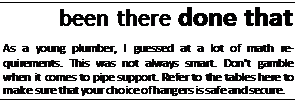FIGURING THE WEIGHT OF A PIPE
Figuring the weight of a pipe and its contents is necessary when you are choosing the needed strength of a pipe hanger. There is a formula that you can use to accomplish this goal. Let’s say that you want to know how much a
|
Nominal pipe size (NPS), in IP |
ASHRAE std. wt. size, mm |
AWWA pipe size, mm |
NFPA pipe size, mm |
ASTM copper tube size, mm |
Nominal pipe size DN, mm |
|
Vs |
— |
_ |
— |
в |
6 |
|
3/ie |
— |
— |
— |
8 |
8 |
|
У4 |
8 |
— |
— |
10 |
10 |
|
% |
10 |
— |
— |
12 |
12 |
|
y2 |
15 |
12.7 & 13 |
12 |
15 |
15 |
|
% |
— |
— |
18 |
18 |
|
|
3/4 |
20 |
— |
— |
22 |
20 |
|
1 |
25 |
25 |
25 & 25.4 |
28 |
25 |
|
Г/4 |
32 |
— |
33 |
35 |
32 |
|
1У2 |
40 |
45 |
38 & 38.1 |
42 |
40 |
|
2 |
50 |
50 & 50.8 |
51 |
54 |
50 |
|
2Уг |
65 |
63 & 63.5 |
63.5 & 64 |
67 |
65 |
|
3 |
80 |
75 |
76 & 80 |
79 |
80 |
|
ЗУ2 |
— |
— |
89 |
— |
90 |
|
4 |
100 |
100 |
102 |
105 |
100 |
|
4У2 |
— |
114.3 |
115 |
||
|
5 |
— |
— |
127 |
130 |
125 |
|
6 |
150 |
150 |
152 |
156 |
150 |
|
8 |
200 |
200 |
203 |
206 |
200 |
|
10 |
250 |
250 |
— |
257 |
250 |
|
12 |
300 |
300 |
305 |
308 |
300 |
|
14 |
— |
350 |
— |
350 |
|
|
18 |
— |
400 |
— |
400 |
|
|
18 |
— |
— |
— |
450 |
|
|
20 |
— |
500 |
— |
500 |
|
|
24 |
— |
600 |
— |
600 |
|
|
28 |
700 |
||||
|
30 |
750 |
||||
|
32 |
800 |
||||
|
36 |
900 |
||||
|
40 |
1000 |
||||
|
44 |
1100 |
||||
|
48 |
1200 |
||||
|
52 |
1300 |
||||
|
56 |
1400 |
||||
|
60 |
1500 |
FIGURE 11.2 ■ Equivalent metric (SI) pipe sizes. (Courtesy of McGraw-Hill)
piece of pipe weighs. You will need some information, which can be found in Figure 11.5. And, you will need the formula, which is as follows:
W = F X 10.68 X T X (O. D. – T)
You’re probably wondering what all the letters mean, and you should be. I’ll tell you. The letter W is the weight of the pipe in pounds per foot. A relative
|
Nominal rod diameter, in |
Root area of thread, in2 |
Maximum safe load at rod temperature of 650°F, lb |
|
Vi |
0.027 |
240 |
|
s/ie |
0.046 |
410 |
|
% |
0.068 |
610 |
|
Vi |
0.126 |
1,130 |
|
% |
0.202 |
1,810 |
|
3/4 |
0.302 |
2,710 |
|
% |
0.419 |
3,770 |
|
1 |
0.552 |
4,960 |
|
lVs |
0.693 |
6,230 |
|
lVi |
0.889 |
8,000 |
|
1% |
1.053 |
9,470 |
|
IVi |
1.293 |
11,630 |
|
1% |
1.515 |
13,630 |
|
13A |
1.744 |
15,690 |
|
1% |
2.048 |
18,430 |
|
2 |
2.292 |
20,690 |
|
2У« |
3.021 |
27,200 |
|
2 Vi |
3.716 |
33,500 |
|
2% |
4.619 |
41,600 |
|
3 |
5.621 |
50,600 |
|
3Vi |
6.720 |
60,500 |
|
ЗУ2 |
7.918 |
71,260 |
FIGURE 11.3 ■ Load ratings of threaded rods. (Courtesy of McGraw-Hill)
|
Pipe size, in |
Rod size, in |
|
2 and smaller |
3/8 |
|
2Vi to 3Vi |
Vi |
|
4 and 5 |
5/« |
|
6 |
3/4 |
|
8 to 12 |
% |
|
14 and 16 |
1 |
|
18 |
lVfe |
|
20 |
Г/4 |
|
24 |
IVi |
FIGURE 11.4 ■ Recommended rod sizes for individual pipes. (Courtesy of McGraw-Hill)
weight factor, which can be found in Figure 11.5, is represented by the letter F. Wall thickness of a pipe is known as the letter T. You have probably guessed that O. D. represents the outside diameter of the pipe, in inches. I said that you could figure out the weight of pipe and its contents. To determine the weight of water in pipe, refer to Figure 11.6.
 |
 |
FIGURE 11.5 ■ Relative weight factors for metal pipe. (Courtesy of McGraw-Hill)
|
IPS, in |
Weight per foot, lb |
Length in feet containing 1 ft3 of water |
Gallons in 1 linear ft |
|
‘/4 |
0.42 |
0.005 |
|
|
% |
0.57 |
754 |
0.0099 |
|
l/2 |
0.85 |
473 |
0.016 |
|
% |
1.13 |
270 |
0.027 |
|
1 |
1.67 |
166 |
0.05 |
|
ІУ4 |
2.27 |
96 |
0.07 |
|
P/2 |
2.71 |
70 |
0.1 |
|
2 |
3.65 |
42 |
0.17 |
|
2У2 |
5.8 |
30 |
0.24 |
|
3 |
7.5 |
20 |
0.38 |
|
4 |
10.8 |
11 |
0.66 |
|
5 |
14.6 |
7 |
1.03 |
|
6 |
19.0 |
5 |
1.5 |
|
8 |
25.5 |
3 |
2.6 |
|
10 |
40.5 |
1.8 |
4.1 |
|
12 |
53.5 |
1.2 |
5.9 |
FIGURE 11.6 ■ Weight of steel pipe and contained water. (Courtesy of McGraw-Hill)






Leave a reply